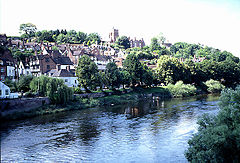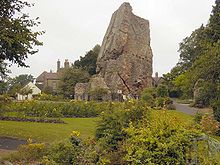Bridgnorth: Difference between revisions
No edit summary |
|||
| Line 62: | Line 62: | ||
A number of notable people have been born in Bridgnorth, including [[Thomas Percy]], bishop of Dromore, the editor of the Reliques of Ancient English Poetry, and [[David Preece]] (May 28, 1963 – July 20, 2007), an English professional footballer who played in midfield, who played three times for the England B team. [[Dominic Sandbrook]], a British historian and writer, was also born in Bridgnorth, in 1974. [[Francis Moore (astrologer)|Francis Moore]] (1657 - 1715), the originator of Old Moore's Almanack was another person born in Bridgnorth. |
A number of notable people have been born in Bridgnorth, including [[Thomas Percy]], bishop of Dromore, the editor of the Reliques of Ancient English Poetry, and [[David Preece]] (May 28, 1963 – July 20, 2007), an English professional footballer who played in midfield, who played three times for the England B team. [[Dominic Sandbrook]], a British historian and writer, was also born in Bridgnorth, in 1974. [[Francis Moore (astrologer)|Francis Moore]] (1657 - 1715), the originator of Old Moore's Almanack was another person born in Bridgnorth. |
||
[[Richard Baxter]] (November 12, 1615 - December 8, 1691) the English [[Puritan]] church leader, divine scholar and controversialist, called by [[Dean Stanley]] "the chief of English [[Protestant]] Schoolmen" lived in Bridgnorth town centre, between 1638-1640. Another former resident of the town, [[Max Rafferty (Musician)|Max Rafferty]], a musician, attended Bridgnorth Endowed School. Rafferty |
[[Richard Baxter]] (November 12, 1615 - December 8, 1691) the English [[Puritan]] church leader, divine scholar and controversialist, called by [[Dean Stanley]] "the chief of English [[Protestant]] Schoolmen" lived in Bridgnorth town centre, between 1638-1640. Another former resident of the town, [[Max Rafferty (Musician)|Max Rafferty]], a musician, attended Bridgnorth Endowed School. Rafferty played bass guitar in indie rock band [[The Kooks]] until 30th January 2008. [[Martin Butler]] (born 15 September 1974 in Dudley, England) is an English football striker with [[Walsall F.C.|Walsall FC]], who spent much of his youth resident in the town. |
||
Current residents of the town include [[ Joe Kershaw]] who has devoted his life to peace and tranquility in the surrounding areas with his base in [[Broseley]]. [[Nik "Rusty" Tyler]] the famous authour and poet also lives in Bridgnorth. He has written many poems including "spammy" and "an ode to lamp". |
|||
==Closest cities, towns and villages== |
==Closest cities, towns and villages== |
||
Revision as of 15:34, 11 April 2008
| Bridgnorth | |
|---|---|
 High Town from the River Severn | |
| Population | 12,212 |
| OS grid reference | SO716927 |
| District | |
| Shire county | |
| Region | |
| Country | England |
| Sovereign state | United Kingdom |
| Post town | BRIDGNORTH |
| Postcode district | WV15, WV16 |
| Dialling code | 01746 |
| Police | West Mercia |
| Fire | Shropshire |
| Ambulance | West Midlands |
| UK Parliament | |
Bridgnorth is a town in Shropshire, England, along the Severn Valley. It is split into Low Town and High Town, named on account of their elevations relative to the River Severn, which separates the upper town on the right bank from the lower on the left. Bridgnorth is named after a bridge over the River Severn, built further north than an earlier bridge at Quatford. It is the seat and most populous town of Bridgnorth district. The population of the town of Bridgnorth was 11,891 at the 2001 Census and a more recent estimate puts it at 12,212 [1].
History
The early history of Bridgnorth is connected with Æthelfleda, lady of the Mercians, who raised a mound there in 912 as part of her offensive policy against the Danes of the five boroughs. After the Norman Conquest William the Bastard granted the manor of Bridgnorth to Earl Roger of Shrewsbury, whose son Robert de Belesme transferred his castle and borough from Quatford to Bridgnorth, but on Robert's attainder in 1102 the town became a royal borough. Later, in 1546, the town was incorporated by James I.
It is probable that Henry I granted the burgesses certain privileges, for Henry II confirmed to them all the franchises and customs which they had in the time of Henry I. King John in 1215 granted them freedom from toll throughout England except the city of London, and in 1227 Henry III conferred several new rights and liberties, among which were a gild merchant with a hanse. These early charters were confirmed by several succeeding kings, Henry VI granting in addition assize of bread and ale and other privileges. The burgesses returned two members to parliament in 1295, and continued to do so until 1867, when they were assigned only one member. The burgesses were additionally granted two fairs: a yearly fair on the feast of the Translation of St. Leonard and three following days was granted in 1359, and in 1630, Charles I granted them licence to hold another fair on the Thursday before the first week in Lent and two following days.
The town was disfranchised in 1885.
In 1978, Bridgnorth twinned itself with the French town of Thiers, and later in 1992 it also twinned with the Bavarian town of Schrobenhausen, Germany that was already twinned with Thiers since a few years. On August 21, 2003, Bridgnorth was granted Fairtrade Town status.
In 2005, unverified German papers dating from 1941 were found, outlining new details about Operation Sealion, the military plans of Nazi Germany for an invasion of Britain. The plan was never carried out but included details about two quiet Shropshire towns in the documentation—Ludlow and Bridgnorth. Some experts now believe that it was Hitler's intention to make Bridgnorth the German headquarters in Britain, due to its central position in the UK, rural location, rail connections and now-disused airfield. [2]
Landmarks



Bridgnorth has a number of features and attractions in it, some of which are of significant importance. The town also possesses a large number of buildings of the half-timbered architectural style, including the town hall. The ruins of a castle, Bridgnorth Castle, are also present in the town.
Bridgnorth is home to a funicular railway that links the high and low towns, the Castle Hill Railway, which is the steepest and only inland railway of its type in the country. Additionally, within the Low Town is Bridgnorth railway station on the Severn Valley Railway, which runs southwards to Kidderminster.
In terms of culture and entertainment, there is a theatre, the Theatre On The Steps, and a 1930s cinema (still in use), the Majestic, originally having one screen, but now three. The town has a number of bars and restaurants and, beyond these, there are 27 pubs, most of which traditional, which makes the town attractive to many tourists,such as the Railwayman's Arms, Golden Lion, King's Head, Stables, Bear, Shakespeare and Bell and Talbot.
High Town is dominated by two Anglican or Church of England churches, St. Mary's church, a church built in the classic style of the late 18th century, which was designed by Thomas Telford. The design of this church appears to have inspired two 19th century Dublin churches - St. Stephen's on Mount Street[1] and the presently closed St. Paul's on Arran Quay, Dublin.[2] The latter 's cupola (dome) is similar to that of St. Mary's, but was built some 40 years later. The dome of the College Hall at RAF College Cranwell also shows strong similarities to the cupola of St. Mary's. The other church in High Town is St. Leonard's, which was formerly collegiate and largely rebuilt in 1862.
Other notable buildings in the town are the seventeenth century Bridgnorth Town Hall and a surviving town gate. Daniel's Mill, a well known watermill is situated a short distance along the River Severn from Bridgnorth.
Education
There are a number of Primary Schools in Bridgnorth, including: Castlefields County Primary School, two Church of England schools, St Mary's and St Leonard's; the Roman Catholic St John's school; and, in addition, the Morville and Brown Clee schools.
The town has two Secondary schools: Oldbury Wells School and The Endowed School. These serve the town and its outlying villages, including Alveley and Highley.
Sport
Bridgnorth Town F.C. are the local football club based in Bridgnorth. They joined the Worcestershire Combination in 1938 and have twice reached the 5th round of the FA Vase. They are currently playing in the West Midlands Regional League Premier Division having moved from the Midland Football Combination in 2006.
Bridgnorth Spartans Juniors Football Club is one of the biggest junior football clubs in Shropshire, running 21 teams in the 2007/08 season. These teams include 16 boys' teams, ranging from Under-8's to Under-16's, 4 girls' teams and a ladies team. They also run a crèche for 3 to 7 year-olds at St Mary's School on Saturday mornings called Little Spartans. Home games are played at Oldbury Wells School on Saturdays and Sundays throughout the season. The home kit features a colour scheme of red & black, arranged in stripes.
In 2007, Bridgnorth hosted the UK Downhill Street Race in Cycling.
Notable residents
A number of notable people have been born in Bridgnorth, including Thomas Percy, bishop of Dromore, the editor of the Reliques of Ancient English Poetry, and David Preece (May 28, 1963 – July 20, 2007), an English professional footballer who played in midfield, who played three times for the England B team. Dominic Sandbrook, a British historian and writer, was also born in Bridgnorth, in 1974. Francis Moore (1657 - 1715), the originator of Old Moore's Almanack was another person born in Bridgnorth.
Richard Baxter (November 12, 1615 - December 8, 1691) the English Puritan church leader, divine scholar and controversialist, called by Dean Stanley "the chief of English Protestant Schoolmen" lived in Bridgnorth town centre, between 1638-1640. Another former resident of the town, Max Rafferty, a musician, attended Bridgnorth Endowed School. Rafferty played bass guitar in indie rock band The Kooks until 30th January 2008. Martin Butler (born 15 September 1974 in Dudley, England) is an English football striker with Walsall FC, who spent much of his youth resident in the town.
Current residents of the town include Joe Kershaw who has devoted his life to peace and tranquility in the surrounding areas with his base in Broseley. Nik "Rusty" Tyler the famous authour and poet also lives in Bridgnorth. He has written many poems including "spammy" and "an ode to lamp".
Closest cities, towns and villages
References
- This article incorporates text from a publication now in the public domain: Chisholm, Hugh, ed. (1911). Encyclopædia Britannica (11th ed.). Cambridge University Press.
{{cite encyclopedia}}: Missing or empty|title=(help)
- ^ "Bridgnorth". world-gazetteer.com.
- ^ "Hitler's secret Shropshire plans". BBC.
